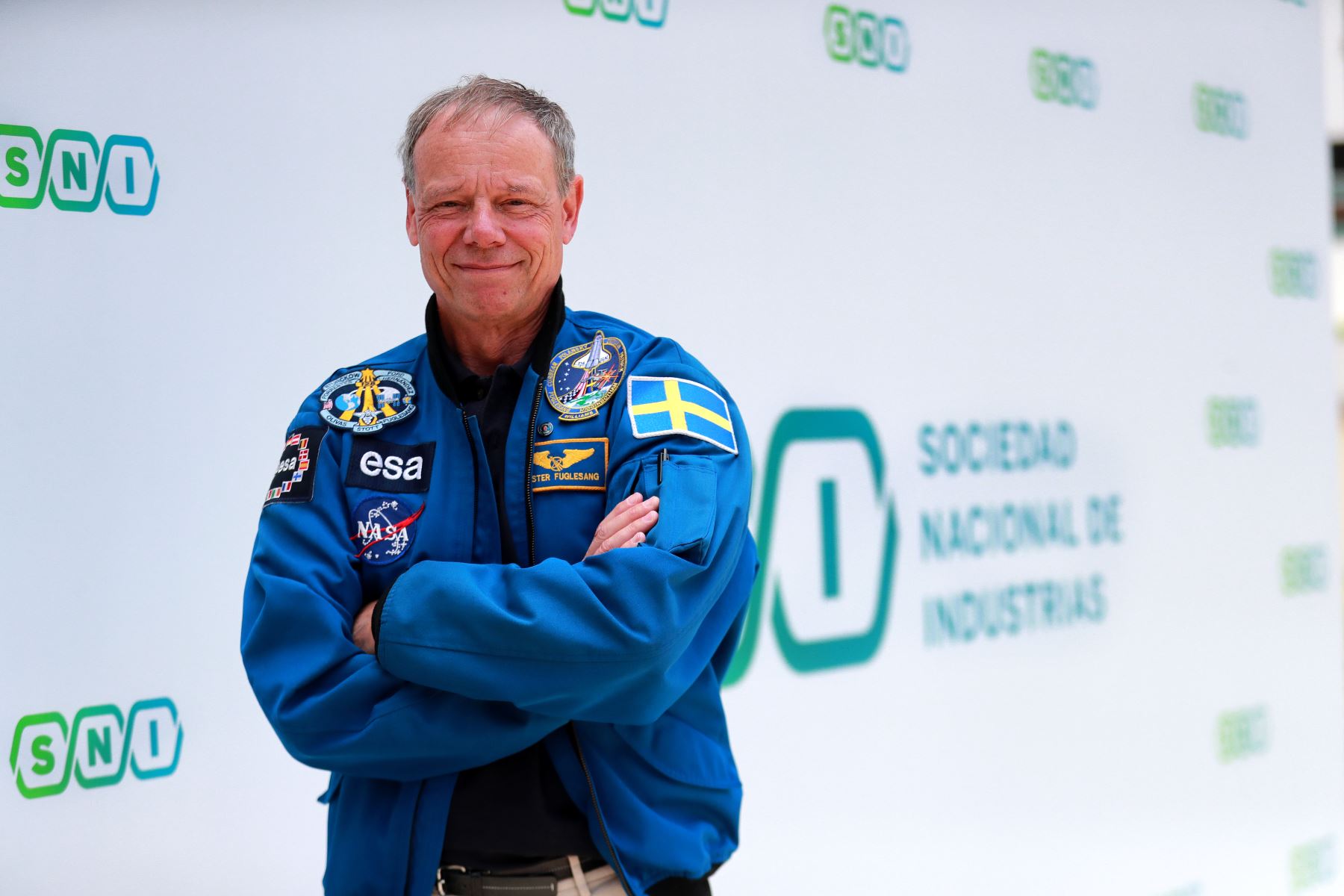By María Fernández Arribasplata“Being in space is great fun, but it’s also a bit tricky; for example, you can’t take a shower,” says Christer Fuglesang, laughing. The first Swedish astronaut came to Peru to share his experience and inspire young people through science.
For the physicist, there are now more ways to reach space, and he is convinced that Peru has strong aerospace potential.
Christer Fuglesang served as an active astronaut with the European Space Agency (ESA) for 18 years and flew twice aboard NASA’s Space Shuttle Discovery to the International Space Station: in 2006 (STS-116) and 2009 (STS-128). During those missions, he completed five spacewalks.
“That was one of the most enjoyable things I ever got to do in space,” he says in an interview with Andina News Agency.
During a two-hour talk at the headquarters of the National Society of Industries, surrounded by curious students and business leaders interested in the aerospace sector, Fuglesang recalled his time in orbit with a touch of nostalgia. In total, he spent 27 days floating in space.
“There are two particular things that happen when you’re up there. One is weightlessness, you just float and float. It’s fun to a certain point, but also a bit complicated. For instance, you can’t get a shower. Honestly, it’s not that good for your body. The other wonderful thing about being in space is the view, the incredible view of our planet,” says the Swedish astronaut.
Upon returning to Earth, he remembers how the body must readjust to gravity and to gain weight again. “That can be a bit difficult, especially if you’ve been in space for a long time. But after two weeks, it wasn’t too bad,” Fuglesang recalls.
Space dreams
For the Swedish physicist, mathematics is a fundamental foundation for anyone pursuing a career in space exploration, but it’s not the only one. Good physical condition and teamwork skills are also essential.
“It’s a wonderful experience if you have the opportunity to become an astronaut. Most astronauts have a background in science, technology, engineering, or medicine. But that’s not enough, you also have to be in good health. You need decent physical fitness and must be good at cooperating with others. Social skills and teamwork are very important,” he explains.
Thanks to his work as an astronaut, Fuglesang met Carlos Noriega, the first Peruvian astronaut, who flew into space aboard NASA’s Atlantis shuttle in 1997. That was Noriega’s first spaceflight. As remembered, in December 2000, Noriega returned to space on mission STS-97 aboard the Endeavour.
“In a way, we worked together on several things, and I used to run into him quite often at NASA headquarters,” Fuglesang recalls.
Looking to the future, the Swedish astronaut believes that every country —even small ones— will eventually have its own astronauts. Unlike the past, when Carlos Noriega had to become a U.S. citizen to join NASA, the new era of space access is far more open.
“What’s interesting now is that NASA is no longer the only big player. There are many private companies, like SpaceX, building space stations, and that creates new opportunities. With a good education and a bit of luck, you can find an exciting job with these companies. In the future, they’ll even be sending their own employees to space. That’s another possible path to space,” he emphasizes.

Peru’s aerospace potential
Fuglesang is also convinced of Peru’s strong aerospace potential. The country’s proximity to the equator offers a major economic advantage for space launches.
The astronaut highlights that a spaceport on Peru’s coast could work very well for research rockets that launch and return, a model Sweden has successfully used for 60 years.
“This type of launch has helped Sweden develop space technologies and sparked great interest in research. It would work well on Peru’s coast,” says the physicist.
It is worth noting that the Peruvian government has formally expressed its intention to include the construction of a future spaceport among its public investment projects, according to the Multiyear Investment Report on Public-Private Partnerships from the Ministry of Defense for the period 2023–2026.
The growth of space business
For Fuglesang, it is crucial to understand that the space industry is growing two to three times faster than most other sectors and is becoming integrated into every aspect of society.
“Ignoring the opportunities that space offers can put an entrepreneur at a disadvantage, while embracing them can create a significant competitive edge. It’s important to realize that space today is part of everything we do. We don’t just need rockets or shuttles, through satellites, we can improve communication,” he notes.
As the author of the children’s book A Crazy Adventure in Space, Fuglesang aims to inspire younger audiences to learn more about science by sharing stories from his space missions.
His final message: science is fundamental for building a better society, and space can serve as both a powerful tool and a source of inspiration for young people to learn and explore more.
Today, he works as a professor at the Royal Institute of Technology (KTH) in Stockholm, chairs the Advisory Board of the Aerospace Master’s Program, and teaches a course on human spaceflight.
He also directs the KTH Space Center and chairs the European Space Education Resource Office (ESERO) in Sweden.
His research focuses on space particles, including the radiation of ultra-high-energy cosmic rays, and on studying the possibility of installing space-based sunshades to help regulate global temperature.
More in Andina:
(END) MFA / JMP / MDV
Published: 10/21/2025